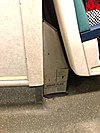
A tram stop, tram station, streetcar stop, or light rail station is a place designated for a tram, streetcar, or light rail vehicle to stop so passengers can board or alight it. Generally, tram stops share most characteristics of bus stops, but because trams operate on rails, they often include railway platforms, especially if stepless entries are provided for accessibility. However, trams may also be used with bus stop type flags and with mid-street pavements as platforms, in street running mode.
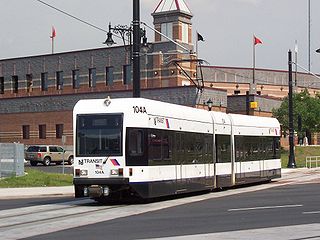
The Newark Light Rail (NLR) is a light rail system serving Newark, New Jersey, and surrounding areas, owned by New Jersey Transit and operated by its bus operations division. The service consists of two segments, the original Newark City Subway (NCS), and the extension to Broad Street station. The City Subway opened on May 16, 1935, while the combined Newark Light Rail service was officially inaugurated on July 17, 2006.

The Green Line is a semi-metro system run by the Massachusetts Bay Transportation Authority (MBTA) in the Boston, Massachusetts, metropolitan area. It is the oldest MBTA subway line, and with tunnel sections dating from 1897, the oldest subway in North America. It runs underground through downtown Boston, and on the surface into inner suburbs via six branches on radial boulevards and grade-separated alignments. With an average daily weekday ridership of 101,000 in 2023, it is among the most heavily used light rail systems in the country. The line was assigned the green color in 1967 during a systemwide rebranding because several branches pass through sections of the Emerald Necklace of Boston.

The Metro Blue Line is a 12-mile (19.3 km) light rail line in Hennepin County, Minnesota, that is part of the Metro network. It travels from downtown Minneapolis to Minneapolis–Saint Paul International Airport and the southern suburb of Bloomington. Formerly the Hiawatha Line prior to May 2013, the line was originally named after the Milwaukee Road's Hiawatha passenger train and Hiawatha Avenue, reusing infrastructure from the former and running parallel to the latter for a portion of the route. The line opened June 26, 2004, and was the first light rail service in Minnesota. An extension, Bottineau LRT, is planned to open in 2028.

The Siemens–Duewag U2 is a type of light rail vehicle (LRV), built by consortium of Siemens, Duewag and Wegmann & Co built between 1968 and 1990.

The Massachusetts Bay Transportation Authority (MBTA) system is mostly but not fully accessible. Like most American mass transit systems, much of the MBTA subway and commuter rail were built before wheelchair access became a requirement under the Americans with Disabilities Act of 1990. The MBTA has renovated most stations to be compliant with the ADA, and all stations built since 1990 are accessible. The MBTA also has a paratransit program, The Ride, which provides accessible vehicles to transport passengers who cannot use the fixed-route system.

The Bombardier Flexity Swift is a series of urban and inter-urban tram, light rail and light metro vehicles manufactured by Bombardier Transportation. It is part of the Bombardier Flexity family of rail vehicles, and like the others, Flexity Swift vehicles can be customized to suit the needs and requirements of customers including legacy designs from its acquisition of Adtranz.

The Siemens S70 and its successor, the Siemens S700, are a series of articulated low-floor light-rail vehicles (LRV) and modern streetcars manufactured for the United States market by Siemens Mobility, a division of German conglomerate Siemens AG. The series also includes a European tram-train variant, the Siemens Avanto.

The Baltimore Light RailLink is a light rail system serving Baltimore, Maryland, United States, and its northern and southern suburbs. It is operated by the Maryland Transit Administration. In downtown Baltimore, it uses city streets. Outside the central portions of the city, the line is built on private rights-of-way, mostly from the defunct Northern Central Railway, Baltimore and Annapolis Railroad and Washington, Baltimore and Annapolis Electric Railway. The system had a ridership of 3,546,300, or about 13,700 per weekday, as of the second quarter of 2024.
Accessibility for people with disabilities on the Toronto Transit Commission (TTC) system is incomplete but improving. Most of the Toronto subway system was built before wheelchair access was a requirement under the Ontarians with Disabilities Act (ODA). However, all subway stations built since 1996 are equipped with elevators, and elevators have been installed in 45 stations built before 1996. Over three-quarters of Toronto's subway stations are accessible. The original plan was to make all stations accessible by 2025; however, a few stations might not be accessible until 2026.
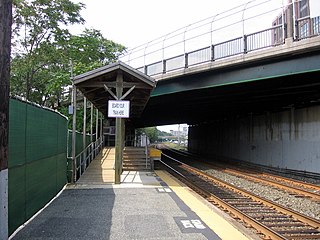
Railway platform height is the built height – above top of rail (ATR) – of passenger platforms at stations. A connected term is train floor height, which refers to the ATR height of the floor of rail vehicles. Worldwide, there are many, frequently incompatible, standards for platform heights and train floor heights. Where raised platforms are in use, train widths must also be compatible, in order to avoid both large gaps between platforms and trains and mechanical interference liable to cause equipment damage.

A wheelchair lift, also known as a platform lift, or vertical platform lift, is a fully powered device designed to raise a wheelchair and its occupant in order to overcome a step or similar vertical barrier.
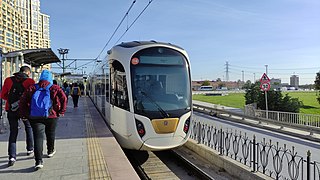
The Istanbul Tram is a modern tram system on the European side of Istanbul. The first section, the T1 opened in 1992, followed by the T2, which opened in 2006. In 2011, the T1 and T2 merged, with the line retaining the T1 name. The T4, T5 and the T6 lines followed, opening in 2007, 2021 and 2024 respectively.

High-floor describes the interior flooring of commuter vehicles primarily used in public transport such as trains, light rail cars and other rail vehicles, along with buses and trolleybuses. Interior floor height is generally measured above the street surface or above the top of the rail. High-floor designs usually result from packaging requirements: mechanical items such as axles, motors, crankshafts, and/or transmissions, or luggage storage spaces are traditionally placed under the interior floor of these vehicles. The term is used in contrast with low-floor designs, which offer a decreased floor and entry height above the street surface. Since low-floor designs generally were developed after high-floor vehicles, the older high-floor design is sometimes also known as conventional or the “traditional” design.

The Alstom Flexity is a family of trams, streetcars, and light rail vehicles manufactured by Bombardier Transportation, since 2021 a division of French company Alstom. As of 2015, more than 3,500 Flexity vehicles are in operation around the world in Europe, Asia, Oceania, and North America in 100 cities among 20 countries internationally. Production of the vehicles is done at Bombardier's global production plants and by local manufacturers worldwide through technology transfer agreements.
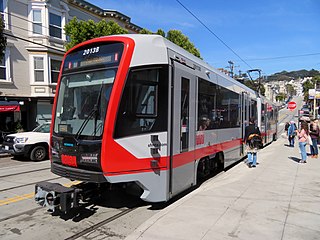
The Siemens S200 is a high-floor light rail vehicle (LRV) manufactured by Siemens Mobility in Florin, California, beginning service in 2016.

The Kinki Sharyo Super Light Rail Vehicle (SLRV) is a light rail vehicle manufactured by Kinki Sharyo, operated by Dallas Area Rapid Transit (DART), and modified jointly by the two companies.

The SacRT light rail system serves the Sacramento, California area. It is operated by the Sacramento Regional Transit District (SacRT) and has 42.9 miles (69.0 km) of network comprising three main lines on standard gauge tracks, 53 stations, and a fleet of 121 vehicles. With an average of 21,700 weekday daily boardings as of the second quarter of 2024, the SacRT light rail system is the fifteenth busiest in the United States.

The TriMet transit system, serving the Portland metropolitan area in Oregon, owns and operates two different rail transit systems: a light rail system known as MAX, and a commuter rail system known as WES. The fleet of 145 MAX electric light rail vehicles (LRVs) includes five different models, designated by TriMet as "Type 1" through "Type 6". All types are used on all of the MAX lines, but the Type 6 cars – which will gradually replace the Type 1 cars – are still being delivered and have not yet begun to enter service. The comparatively very small WES fleet includes three different types of diesel commuter rail cars.

The Siemens SD660, originally known as the Siemens SD600, is a double-articulated, 70%-low-floor light rail vehicle (LRV) manufactured by Siemens Transportation Systems. It was the first low-floor light rail vehicle to be used in the United States. It first entered service in 1997 with its only operator, TriMet, on the MAX light rail system in Portland, Oregon, United States.


